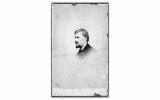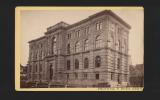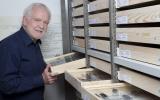Our entomologist Charles Huber first happened upon Albert Müller by chance. Leafing through an old album containing photographs of different insect researchers, he was puzzled to stumble across a name he did not know: Albert Müller. According to the inscription, Albert Müller was not only Huber’s predecessor, but also Bern’s first conservator of entomology. Huber was surprised that the name of his predecessor was not more familiar to him and began to research his life. The painstaking investigation took almost two years and eventually unearthed a life story straight out of Hollywood, with a tragic ending.
First, however, there was a lot of legwork to be done, and Huber had to be creative in his search for useful clues. He tracked down Müller’s personnel file, for example, and he was able to glean valuable information by comparing the inscription on Müller’s photograph with labels in the NMBE’s insect collection that featured identical handwriting. The research increasingly took on the nature of fastidious detective work: Huber waded through stacks of proceedings for Bern’s Entomological Association, of which Albert Müller was a member, traced his family’s roots and sought out his scientific publications.
Gradually, Huber was able to piece together the fragments, and the biography of Albert Müller began to take shape. ‘I soon had a sense that there was a fascinating story behind Albert Müller,’ relates Huber – and he was certainly proven right. What started out as a little background research ended with the penning of a whole life story.
Charles Huber joined the Natural History Museum of Bern as a collection assistant in 1976 and has been with the museum ever since. Between 1988 and 1995, he was temporary conservator of entomology, and from 1995 to 2015 he held the position of curator of entomology. He became vice president of Bern’s Entomological Association (EVB) in 1994 and remained in the post for around 20 years. In addition to the biography Das vergessene Leben des Entomologen Albert Müller aus Basel (The Forgotten Life of Entomologist Albert Müller of Basel, 2019), he is the author of several other books and publications, including the history of the EVB, Die Ringe des Apollo (The Rings of Apollo, 2008). Since retiring, Huber has continued to work at the NMBE and has served as a research associate on a range of projects.
A life worthy of a film script
Albert Müller was born in 1844 and grew up in humble circumstances in Kleinbasel. He took a keen interest in the science of insects from a very early age, but the family’s financial constraints forced him to serve an apprenticeship in commerce. Nevertheless, while working as an apprentice, he established contact with researchers in the field and quickly acquired expertise. At the tender age of 17, he became a member of the Swiss Entomological Society.
At 20, Albert Müller left Basel and joined his brother in London. He worked in commerce, but the love of entomology never left him. He eagerly continued his research and his first publications soon followed. The young man from Basel established a large network of connections in England’s capital city, joined the renowned Entomological Society and even began a correspondence with the famous scientist Charles Darwin.
During his time in London, however, Albert Müller never lost touch with his connections in Switzerland, and in 1874, when the post of director of the new zoological garden in Basel was advertised, the insect researcher applied. At the age of just 30, Müller became the first director of the establishment we affectionately know today as the ‘Zolli’. All did not go to plan, however: due to various factors, including the precarious financial situation, Müller’s appointment ended after just a few months. Instead of feeling sorry for himself, Albert Müller threw himself into research again and opened his own Entomological Station – a small educational institute – in Basel. Five years later, the man from Basel was appointed the first entomological conservator at the Natural History Museum of Bern. The appointment was rather surprising, given that there were other local candidates for the post.

A dramatic turning point
During his second year as conservator in Bern, Albert Müller’s career took a dramatic turn. To the concern of those around him, his behaviour became increasingly irrational, and he was plagued by persistent headaches and hallucinations. Before long, he felt he was no longer in a position to continue his work at the NMBE and handed in his notice. A medical certificate shows that he was diagnosed with paranoid schizophrenia. Shortly afterwards, the 37-year-old entomologist was admitted to a ‘lunatic asylum’ that he would never leave. Albert Müller died in 1922 after spending over 40 years in the institution in Basel.
Plunging off the top diving board
How would Albert Müller’s career have turned out if he hadn’t lost half of his life to serious mental illness? Charles Huber, author of Müller’s biography, believes that Müller had a great scientific future ahead of him. Instead, the illness brought the ardent researcher’s career to an abrupt end. Huber likens this dramatic turn of events in Müller’s life to plunging off the top diving board.
Because most of Müller’s publications appeared in England and his collections are not of great scientific importance, he has remained an unknown figure until today, despite his two prestigious appointments in Switzerland.
Charles Huber affectionately refers to Müller as ‘Albertli’ and relates that, through the research, his predecessor at the NMBE has come to feel like a brother. ‘I’m particularly fascinated by the way that Albert Müller, with his humble background, developed such a tremendous passion for the unprofitable business of science,’ explains Huber. Thanks to Charles Huber’s keen research, the fascinating life story of Albert Müller, the first entomological conservator at the NMBE and the first ‘Zolli’ director in Basel, has been rescued from obscurity.
‘The Forgotten Life of Entomologist Albert Müller from Basel’ by Charles Huber appeared (in German) in the series ‘Contributions to Natural History: Scientific Papers from the Natural History Museum Bern’ and is available from contact@nmbe.ch.




